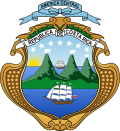

The following outline is provided as an overview of and topical guide to Costa Rica:
Contents
- General reference
- Geography of Costa Rica
- Environment of Costa Rica
- Regions of Costa Rica
- Demography of Costa Rica
- Government and politics of Costa Rica
- Branches of government
- Foreign relations of Costa Rica
- Law and order in Costa Rica
- Military of Costa Rica
- Local government in Costa Rica
- History of Costa Rica
- Culture of Costa Rica
- Art in Costa Rica
- Sports in Costa Rica
- Economy and infrastructure of Costa Rica
- See also
- References
- External links
Costa Rica – sovereign country located in Central America, bordered by Nicaragua to the north, Panama to the east-southeast, the Pacific Ocean to the west and south, and the Caribbean Sea to the east. [1] Costa Rica was the first country in the world to constitutionally abolish its army. [2] Among Latin American countries, Costa Rica ranks 4th on the 2007 Human Development Index, and 48th worldwide. [3] Costa Rica is ranked 5th in the world on the 2008 Environmental Performance Index, up from the 15th place in 2006. [4] [5] In 2007 the government stated that it wants Costa Rica to be the first country to become carbon neutral by 2021. [6] [7] [8]




